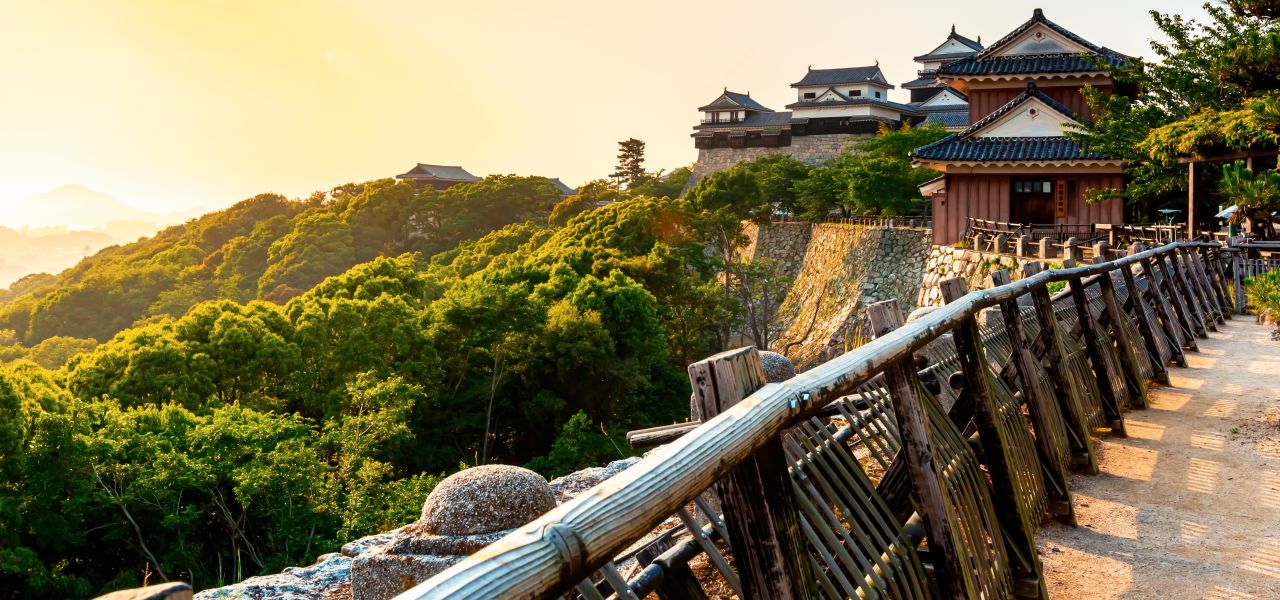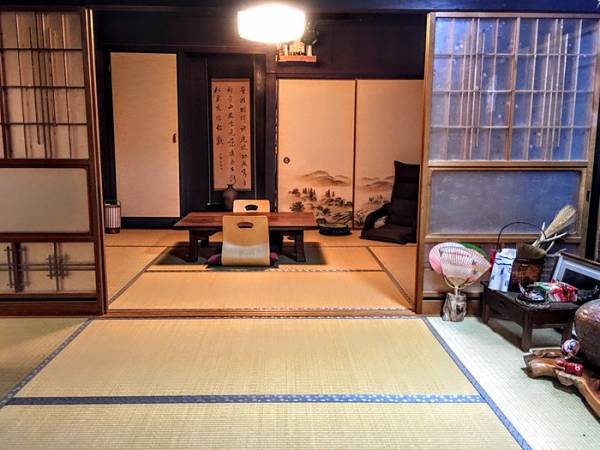Current as of: January 8, 2026 - 01:30

Shikoku Pilgrimage Trail Trip Notes
- Ways to Travel: Self-Guided Holidays
- Programmes: Walking & Trekking
-
Activity Level:
5 out of 7 - Challenging
- 11 Days: Land Only
- Ages: 8+
- Trip Code: W10SH
Trip Overview
Journey the Shikoku Pilgrimage Trail
Shikoku is Japan’s fourth-largest island, home to some of the country’s most spectacular and undeveloped scenery. The island is also home to the ancient walking trail, Shikoku 88 Pilgrimage. The trail connects 88 Buddhist temples with the entire walk covering more than a thousand kilometres.
This spiritual journey follows in the footsteps of Kobo Daishi, also known as Kukai, who reached enlightenment in the isolated mountains and decided to devote his life to the Buddha. Following intense study of Buddhism and the creation of the temple complex on Mount Koya, he never forgot his home island of Shikoku and undertook a journey to visit all its 88 temples. Even today pilgrims from all over the world follow in his footsteps and visit the temples dressed in traditional garb, receiving blessings in the form of food and drinks from the locals.
We have selected the best walks and the best accommodations, including Shukubo pilgrims lodgings and fine inns in appealing cities such as Tokushima and Dogo Onsen near Matsuyama, which offer convenient transport to the trails.
Explore the fascinating city of Kyoto before beginning your Kumano Kodo journey and end with two nights in Osaka. Famous for its beautifully built Buddhist temples and traditional teahouses, Kyoto is a great introduction to your Japanese adventure. From here, you can visit the historical city of Nara, full of cultural treasures and tranquil gardens.
Osaka is known as the food capital of western Japan, inheriting its name in part from the fantastic Dotonbori area in the south of the city. Countless restaurants line the Dotonbori-gawa River offering dinner with views. The city is also home to Osaka-jo – a symbolic castle, re-built to its grand size after repeated fires.

Highlights
- Walk the most beautiful parts of the Shikoku 88 Temple Pilgrimage trail in Tokushima, Kagawa and Ehime
- Climb the iconic ladder to the meditation spot used by Kobo Daishi, founder of Shingon Buddhism
- Experience an authentic pilgrimage journey, staying in traditional Minshuku, Ryokan, and Shukubo temple lodging, with authentic Shojin-Ryori Buddhist vegetarian cuisine
Adult min age: 8
Itinerary
Land Only
- Start City: Osaka
- End City: Osaka
Flight Inclusive
- Start City: London
- End City: London
Land Only Itinerary
Take the express train from Osaka Kansai Int. Airport to Kyoto City (approx. 70mins), then a local taxi to your first hotel. (approx. 10mins).
Overnight Kyoto.
Enjoy a rest day in the incredible city of Kyoto, famous for its Buddhist temples, tranquil gardens, and traditional teahouses. We recommend visiting the historical city of Nara, full of cultural treasures and expansive parks, located approx. 1hr from Kyoto city on the train.
Overnight Kyoto.
Travel by long distance bus to Tokushima Prefecture (included) where you’ll begin your pilgrimage with a gentle introduction to the walks on Shikoku through quiet neighbourhoods of Tokushima. Visit three of the most eye-catching temples on whole trail – Temple 1 Ryozen-ji, Temple 2 Gokuraku-ji and Temple 3 Konsen-ji. Spend your first night as all pilgrims should – with a stay in a Shukubo Temple Lodging. There is also the option of staying at a traditional Ryokan for this first night.
Overnight Shukubo Temple Lodging or Ryokan, Tokushima.
Travel south by pre-booked and pre-paid taxi to Temple 11 Fujii-dera, a fascinating hillside temple complex. After time to explore Fujii-dera, your taxi will bring you to Ryusuian Temple, part-way up the mountain en-route to Shosan-ji. From there you walk up the rest of the mountain to Temple 12 Shosan-ji, then finally descend to the east. The walk is fairly strenuous, but very rewarding with beautiful scenery. Walk onwards to Yorii and board a bus to the small Onsen village of Kamiyama and your inn for the evening.
Overnight Minshuku Guesthouse or Ryokan, Kamiyama.
Travel by pre-paid taxi to one of the most beautiful and varied hikes on the entire Pilgrimage route. From Temple 20 Kakurin-ji the trail descends to the hamlet of Anan, crosses the Nakagawa River and climbs again to Temple 21 Tairyu-ji. End the day with a cable car ride with wonderful views over a cedar forest and the small town below. Travel by bus to your accommodation for the evening.
Overnight Minshuku Guesthouse or Ryokan, Tokushima.
Leaving Tokushima, you’ll take the train, bus and a pre-booked and prepaid taxi to a rewarding hike in northern Kagawa Prefecture. Walk through lovely scenery and visit a fine collection of temples – Temple 82 Negoro-ji, Temple 81 Shiromine-ji and finally Temple 80 Kokubun-ji. Travel onwards by train for an overnight stay in the old hot-spring town of Kotohira Spa.
Overnight Ryokan (traditional Japanese inn), Kotohira Spa.
Leaving Kagawa, travel by train and bus to Betsumyo in northern Ehime and begin your hike to Temple 57 Eifuku-ji. The walk gradually passes from urban townscape to rural farming communities before entering a forest with a steady climb to Temple 58 Senyū-ji. Visit Eifuku-ji and Senyū-ji and there is also an optional detour to Temple 56 Taisan-ji. Overnight at Senyū-ji in the Shukubo pilgrims’ lodgings at the temple, or alternatively stay in a western-style hotel in Imabari City.
Overnight Shukubo Temple Lodging or hotel, Imabari.
Your walk continues with a gentle walk down the mountain from Senyū-ji, with the opportunity to explore small village settlements on the way. Return to the town of Imabari, with an optional paved town hike on to Temple 59 Iyo Kokubun-ji. Take the train from the end of your walk in Iyo-Tomita to Matsuyama, followed by a tram to Dogo Onsen.
Overnight Ryokan (traditional Japanese inn), Dogo Onsen.
Take a pre-paid taxi from your ryokan to Temple 45 Iwaya-ji, a temple closely linked to Kōbō Daishi – the priest who founded Shingon Buddhism and Mount Koya. Climb the iconic ladder to his meditation spot, with its spectacular views over the surrounding region. From Iwaya-ji, enjoy a lovely forest hike to Temple 44 Daiho-ji before returning by bus and tram to Dogo Onsen in the evening.
Overnight Ryokan (traditional Japanese inn), Dogo Onsen.
Your pilgrimage ends with a rewarding hike in the east of Ehime Prefecture. Travel by tram and bus to Ooto, then take a pre-paid taxi to reach the starting point. Walk to Temple 60 Yokomine-ji, Temple 61 Kōon-ji and onwards to Temple 62 Hoju-ji. The walk passes through a rural area of Shikoku and the temples are in lovely natural settings. After the walk, travel onwards by train to Osaka, arriving mid-evening for your final evening.
Overnight Osaka.
Enjoy breakfast at your hotel before taking the train from Osaka Namba Nankai station to Osaka Kansai Airport (approx. 35mins).
Accommodation
Hotels, Shukubo, Ryokan & Minshuku

Hotels: Modern western-style hotels are used. The rooms are generally smaller than equivalent hotels in the West. All have en-suite facilities, air-conditioning, TV, and fridges in rooms.
Shukubo: These are lodgings in Buddhist temples originally meant for pilgrims, but now open to anyone. The rooms are similar to Ryokan or Minshuku, though with fewer facilities. The food is excellent vegetarian Buddhist ‘Shojin-Ryori’ cuisine. It is a wonderful experience to stay in a Shukubo and there is often the opportunity to join the early morning religious service.
Ryokan: Ryokan are traditional Japanese-style inns. They may be in modern concrete or older wooden buildings, but the rooms are always in the Japanese style with tatami (straw) matting and futons laid out in the evening by the ryokan staff. Evening meals* are served together usually in the dining room and are exquisitely prepared multicourse meals. Many ryokans have both en-suite bathrooms (except for some older buildings) and communal hot spring style baths. They are the classic Japanese experience.
Minshuku: Minshuku are usually family-run traditional Japanese-style inns. They have tatami-mat rooms, with futons laid out in the evening for sleeping. Most minshuku do not have en-suite bathrooms as they are in older traditional wooden buildings. Compared with a ryokan, they are usually (but not always) slightly less formal, but the service and food* are just as good.
At these the inns and Shukubo, futon bedding on tatami mat is provided; toilet and bathing facilities may be shared.
*Most meals will be Japanese cuisine. Vegetarian options are available but limited. Strict vegetarian diets, vegan diets, or gluten free diets will be difficult to accommodate due to the pervasiveness of the fish-based stock dashi and the use of soy sauce and miso in Japanese cuisine. Tips are not required when dining in Japan.
What To Take
Practical Information
Visa
Japan
Travellers from the UK, US and EU normally do not need a visa to enter Japan. Please note, visa requirements often change and it is your responsibility to obtain any required visas for this trip. Therefore, we recommend that you check with the nearest embassy or consulate of your chosen destination(s), including any countries you may be transiting or transferring through.
Some local governments provide guidance on what visas their citizens need. To help, we’ve gathered a selection of useful links below.
- Australia: www.smartraveller.gov.au/destinations/asia/japan
- Canada: www.travel.gc.ca/destinations/japan
- United Kingdom: www.gov.uk/foreign-travel-advice/japan/entry-requirements
- USA: www.travel.state.gov/content/travel/en/international-travel/International-Travel-Country-Information-Pages/Japan.html
Vaccinations and Health
Japan
There are no required vaccinations. However, recommended vaccinations include hepatitis B, tetanus, Japanese encephalitis, rabies (bat lyssavirus) and tick-borne encephalitis. Please confirm with your doctor or travel clinic.
Methanol: The FCDO warns travellers to be cautious of methanol poisoning when travelling in destinations visited on the trip.
Local Time
Japan's time zone: Asia/Tokyo (UTC +09:00)
Electricity
Japan's electricity: Plug types A (two flat pins) and B (three pins: two flat, one round) – 100V, 50Hz/60Hz. Most battery chargers function at this voltage, but do check their documentation.

Money
Japan's currency: Japanese yen (JPY)
Sustainability and Impact
As a certified B Corp, we’re on a mission to improve our social and environmental impact across all our adventures.
We do this through our innovative Thriving Nature, Thriving People plan.
This ‘nature positive’ approach is designed to help nature and communities thrive in harmony through practical solutions, such as reducing carbon and waste on our trips, supporting conservation projects through the Exodus Adventure Travels Foundation, and rewilding 100 square metres for every Exodus traveller.